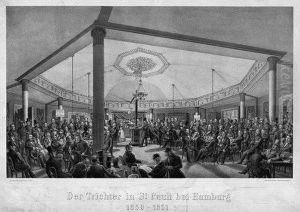Johann Friedrich Frick Paintings
Johann Friedrich Frick was a German painter primarily known for his portraits and historical scenes. He was born in 1749 in Schwäbisch Hall, Germany, and developed an interest in art at an early age. His initial training came from his father, who was also a painter, which provided Frick with a strong foundation in the techniques and principles of art.
During his career, Frick became recognized for his skill in capturing the likeness and character of his subjects. His portraits were often noted for their detailed representation and the lifelike quality he imbued in the eyes of his sitters, which seemed to reflect their inner lives. In addition to portraiture, Frick was also interested in historical and mythological subjects, which were popular among the art patrons of his time.
Despite his evident skill, Frick is not as well-known as some of his contemporaries, which is partly due to the lack of extensive documentation or significant patronage that could have helped promote his work more widely. Nevertheless, his contributions to the art of his period were appreciated by those who commissioned his works and by the communities he was part of.
Johann Friedrich Frick's career spanned a period of significant change in Europe, influenced by the Enlightenment and leading up to the Napoleonic Wars. While not much is documented about his personal life or his thoughts on the political developments of the era, it is likely that the tumultuous times had an impact on the arts and on artists like Frick.
He passed away in 1815, a time when the Romantic movement was beginning to take hold in the arts, marking a shift away from the neoclassical ideals that had dominated during Frick's active years. Although Johann Friedrich Frick might not have achieved the lasting fame of some of his peers, his work remains a testament to the skill and aesthetics of late 18th and early 19th-century German painting.
